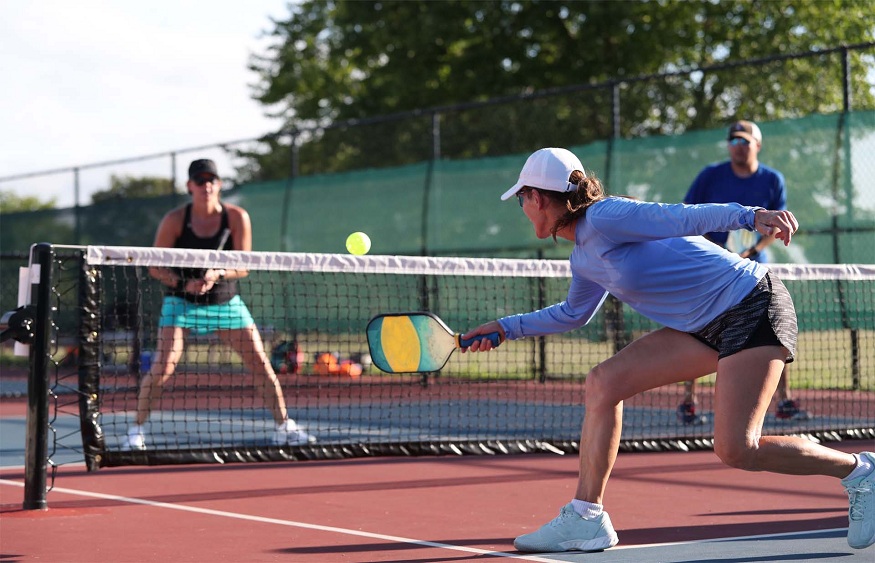The Environmental Impact of Pickleball: Implementing Sustainable Practices and Eco-Friendly Initiatives

Pickleball, a quickly expanding sport renowned for its accessibility and diversity, has been actively looking for methods to lessen its environmental impact and has been addressing it more and more. The sport of Pickleball has realized the necessity to adopt eco-friendly programs and sustainable practices in order to reduce its environmental impact, given its recent growth in popularity and the development of Pickleball communities. This article examines the different ways that the Pickleball community is embracing sustainability and emphasizes how important eco-friendly behaviors are in creating a more ecologically conscious and greener sporting culture.
Read more :Why Should You Undergo SAT Preparation?
Introduction to Pickleball and Sustainability
Pickleball, a hybrid game combining ping-pong, badminton, and tennis, has developed a devoted fan base in recent years because to its fun and easy gameplay. The sport is incorporating sustainable principles into its operations as its popularity soars, highlighting the importance of resource management and environmental concern. The Pickleball community hopes to encourage a sustainable culture and provide a model for other sports and leisure pursuits by implementing eco-friendly initiatives.
The Environmental Footprint of Pickleball: Identifying Key Areas of Impact
Pickleball has a reputation for having little effect on player injuries, but its environmental impact goes beyond the court. The production and disposal of equipment, energy use in the building and maintenance of courts, and waste production from competitions and community play are some of the major areas of influence. Through identification of these domains, the Pickleball community may employ focused tactics to reduce its ecological footprint and foster conservation of the environment.
Sustainable Practices in Pickleball Equipment Manufacturing
Pickleball paddles and balls are manufactured using a variety of materials, many of which have the potential to be harmful to the environment. However, producers can drastically lower their carbon footprint by emphasizing the use of recyclable and sustainable products. Furthermore, adopting environmentally friendly production techniques and investigating substitute, renewable materials can support the Pickleball equipment industry’s overall sustainability.
Eco-Friendly Initiatives in Pickleball Court Construction
Building Pickleball courts offers a chance to include environmentally friendly practices from the ground up. Pickleball courts can drastically lessen their environmental effect by using natural landscaping components, energy-efficient lighting systems, and sustainable building materials. Furthermore, the application of rainwater collecting methods and permeable surfaces can support water conservation initiatives and encourage a more environmentally friendly method of building and maintaining courts.
Energy Efficiency and Pickleball Facility Management
In order to minimize Pickleball facility’ environmental impact, effective energy management is essential. The utilization of solar panels, LED lighting, and smart energy monitoring systems are a few examples of energy-saving techniques that may be put into effect to drastically reduce energy usage and operating expenses. Pickleball courts can support a sustainable approach to facility management and help reduce greenhouse gas emissions overall by using these energy-efficient technologies.
Waste Management in Pickleball Communities: Promoting Recycling and Reuse
Reducing environmental impact in Pickleball communities requires effective trash management. The Pickleball community can play a major role in reducing trash output by supporting recycling initiatives, encouraging the use of recyclable equipment and packaging, and putting waste reduction strategies into practice during tournaments and events. Furthermore, encouraging composting and using biodegradable items can help the Pickleball ecosystem’s sustainability efforts even more.
The Role of Pickleball Organizations in Promoting Environmental Awareness
Organizations dedicated to Pickleball are essential in encouraging sustainability and environmental consciousness in the game. These groups can encourage players, fans, and communities to embrace sustainable behaviors on and off the court by implementing environmental education programs, planning community clean-up events, and lobbying for eco-friendly laws. In addition to encouraging a sense of responsibility, Pickleball groups’ active participation in environmental conservation also pushes for the development of a more environmentally conscious and sustainable Pickleball community.
Community Engagement and Green Initiatives in Local Pickleball Clubs
Local Pickleball clubs have the chance to set an example and take the lead on environmentally friendly projects in their neighborhoods. Pickleball clubs may have a beneficial environmental effect and promote active community involvement by planning ecologically conscious activities, putting in place sustainable infrastructure, and starting community gardens or green areas. Involving club members and neighborhood dwellers in environmentally conscious activities promotes environmental stewardship and develops a sustainable culture in the Pickleball community.
The Impact of Pickleball Tournaments on the Environment: Minimizing Carbon Footprint
Pickleball tournaments can have a big effect on the environment even though they highlight the sport’s ethos of rivalry and friendship. Tournament organizers can lessen the carbon impact of these events by implementing eco-friendly event management techniques such using biodegradable serving utensils, cutting back on single-use plastics, and encouraging responsible transportation options. Additionally, Pickleball tournaments can lessen their environmental impact and help to preserve natural habitats by incorporating carbon-offsetting programs and supporting regional conservation efforts.
Education and Advocacy: Spreading Environmental Consciousness in the Pickleball Community
The Pickleball community’s culture of sustainability is greatly enhanced by advocacy and education. Players and aficionados can learn more about their involvement in environmental conservation by attending workshops, seminars, and online resources that promote eco-friendly activities and raise awareness of the sport’s environmental impact. Furthermore, promoting environmentally friendly laws and programs at the state and federal levels can have a snowball effect that encourages improvement and develops a more ecologically aware Pickleball community..
Partnerships and Collaborations for Sustainable Development in Pickleball
In order to promote sustainable development within the sport, partnerships and collaborations between pickleball organizations, environmental organizations, and local communities are essential. The Pickleball community may pool its resources and expertise to carry out significant and long-lasting projects by joining forces with environmental advocacy organizations, starting cooperative conservation efforts, and forming green collaborations with nearby companies. Long-term, beneficial change within the Pickleball ecosystem is made possible by cooperative efforts and shared commitments to environmental sustainability.
Case Studies of Successful Sustainable Pickleball Initiatives
Many Pickleball communities and organizations, setting an inspiring example for others to follow, have implemented sustainable strategies effectively. Sustainability is a top priority in the Pickleball environment, as evidenced by case studies that show the practical benefits of lower energy use, waste reduction, and community engagement because of these eco-friendly activities. The Pickleball community can learn important lessons and get useful advice on putting into practice sustainable methods that support community well-being and environmental preservation by displaying these excellent case studies.
Assessing the Long-Term Benefits of Eco-Friendly Practices in Pickleball
Beyond only protecting the environment, adopting eco-friendly Pickleball practices has long-term advantages. The general wellbeing of players, communities, and the surrounding ecosystems is enhanced by these behaviors. The Pickleball community can build a more resilient and healthy environment, encourage social cohesiveness and community involvement, and instill a feeling of shared responsibility for the preservation of natural resources by cultivating a sustainable sporting culture. Evaluating and realizing the long-term advantages of environmentally friendly activities highlights how crucial sustainability is to the Pickleball experience.
Challenges and Solutions in Implementing Sustainable Practices in Pickleball
Although Pickleball requires the integration of sustainable techniques, there are several obstacles to overcome. The Pickleball community may face a number of barriers to the implementation of eco-friendly measures, ranging from limited resources and awareness to budgetary constraints. These difficulties can be addressed, though, by creating thorough sustainability plans, encouraging teamwork, and giving emphasis on public awareness and education initiatives. The key to overcoming these obstacles and guaranteeing the effective adoption of eco-friendly Pickleball practices is putting creative solutions into practice and encouraging a culture of sustainability via teamwork and dedication.
Future Outlook: Advancements and Innovations in Sustainable Pickleball Practices
Pickleball’s survival depends on its ongoing dedication to environmental protection and sustainability. The Pickleball community may anticipate developments and breakthroughs in sustainable practices that further reduce the environmental effect of the sport as long as technology and awareness continue to evolve. An eco-aware and resilient sports culture is what sustainable Pickleball practices promise to create in the future, from the creation of environmentally friendly equipment and court materials to the incorporation of renewable energy sources and intelligent waste management systems.
Conclusion
In conclusion, pickleball’s effects on the environment are an important factor in the sport’s continued development and expansion. The Pickleball community can promote an eco-conscious culture, responsible resource management, and long-term sustainability by acknowledging the different ways that Pickleball affects the environment and putting eco-friendly behaviors and projects into action. Pickleball enthusiasts, organizations, and communities can help preserve natural resources, lessen environmental impact, and promote a more sustainable and environmentally friendly sporting culture for future generations by working together, educating the public, and advocating for change.






